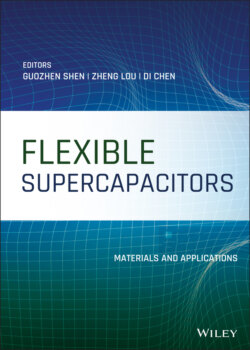Читать книгу Flexible Supercapacitors - Группа авторов - Страница 43
2.3.4 Perspective
ОглавлениеAs a new member of the SC family, stretchable devices have been greatly developed in the past few years, buoyed by the portable and wearable electronics, which need a stretchable energy storage to form a complete and safe system to monitor electrical and biomedical signal generated by human activities, thus achieving the practical application of wearable electronics in the field of biomimetic E‐skins, interactive human‐machine interface, “big health” and “big data.” In this review, we systematically summarize the recent progress in stretchable SCs from the perspective of the three dimension and corresponding configuration of the stretchable device, as well as the fabrication process and strategies toward the stretchable SCs. The stretchable integrated system is also concluded in this chapter, all of them realized stable response to the physical and bio‐signal under different stretching or deformations when attached to the human body, showing potential for wearable electronics.
Despite the considerable achievements in stretchable SCs which have been achieved, there are great challenges still remaining for future practical applications. These challenges and the direction for future development can be summarized as follows: (i) Electrochemical performance of SCs under deformation still requires to be improved. Electrode material is the decisive factor of the electrochemical performance. But most of the stretchable SCs depend on the CNTs, which lead to the low specific capacitance of the devices. Discovering novel kinds of electrode materials and design of various configuration for stretchable SCs are one of the promising directions. (ii) The elastic substrate with high stretchability and skin‐touched feature is desired. The most popular elastic substrate used in stretchable devices is PDMS. However, it possesses hydrophobic properties. Electrode materials with binder like PVDF covered on the PDMS usually need to face the detaching problem, which is not of benefit to the mechanical stability of the devices. A stretchable substrate that ensures electrode materials direct growth on it may be a great way to develop stretchable devices. (iii) More attention should be focused on the development of air stable gel electrolyte. Most of the existing all‐solid‐state gel electrolyte is water‐based polymer gel electrolyte, which have a short lifespan under air ambient conditions. How to improve the lifespan of the water‐based gel electrolyte in the further development of stretchable SCs must be a significant topic. (iv) The integration and encapsulation method is important for wearable integrated system. For the stretchable multifunctional integrated systems powered by SCs containing several kinds of stretchable devices, the integration and encapsulation method that makes every component work tuneful must be considered. The embedding method is a mature way but can't be the only one for packaging the integrated system. (v) More low‐cost fabrication technology for large scale production of stretchable SCs should be introduced to meet the requirement of the practical application. From the angle of actual application, the large‐scale production of stretchable SCs with low cost also should be considered. Overall, stretchable SCs have been proved as a promising energy storage to power the portable and wearable electronics and occupy an indispensable position in the future development and applications of wearable electronics.
